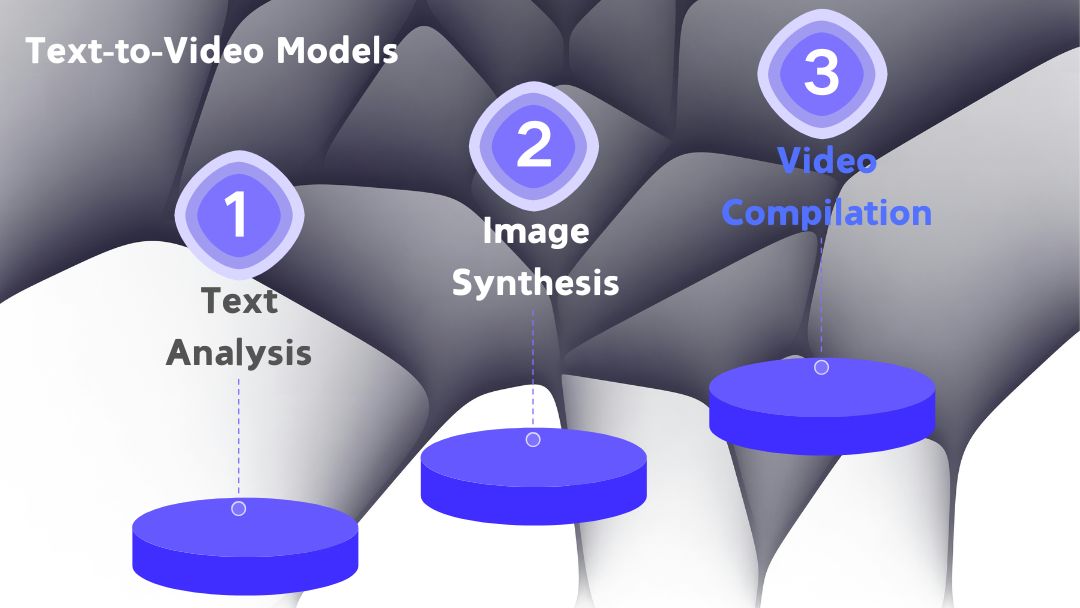Text-to-Video Models: Crafting Videos from Verbal Descriptions

September 27, 2024
Envision a scenario where you can conjure a video into existence by simply articulating a narrative. Text-to-video models are the technological alchemy that transmutes words into visual sequences. In this exploration, we'll unravel the intricacies of these models, their applications, and the promising prospects they hold.
The Essence of Text-to-Video Models
Text-to-video models are sophisticated algorithms capable of translating textual narratives into video formats. They dissect the input text to grasp its meaning and then fabricate a series of images that culminate in a fluid motion picture. This cutting-edge technology employs complex computational recipes to decipher language and render visual content.
Operational Dynamics
The transformation from text to video unfolds in a series of calculated steps:
- Text Analysis: The model deciphers the input sentence, examining word meanings and their contextual relationships.
- Image Synthesis: Post-comprehension, the model generates images aligning with the text description, employing advanced techniques such as transformers and diffusion models for realism.
- Video Compilation: The model then sequences these images into a coherent temporal sequence, imbuing motion and occasionally sound to form a complete video narrative.
Underlying Technologies
Two pivotal technologies empower text-to-video models:
- Transformers: Algorithms adept at language comprehension, facilitating the model's interpretation of textual meaning and contextual connections.
- Diffusion Models: Starting with random noise, these models incrementally refine it into detailed images, contributing to the creation of high-fidelity visual content.
Significance of Text-to-Video Models
These models unlock a plethora of compelling applications:
- Education: Educators can craft engaging video content to elucidate complex subjects, enhancing the learning experience.
- Marketing: Businesses can rapidly produce promotional videos from scripts, bolstering their customer outreach.
- Entertainment: Filmmakers can harness these models to generate scenes or short films, bypassing the need for costly equipment or extensive crews.
- Social Media: Users can generate captivating content for platforms like TikTok or Instagram, their creative concepts and descriptive prowess.
Challenges in Video Generation
Despite the impressive capabilities of text-to-video technology, it faces several challenges:
- Contextual Understanding: Ambiguity in word meanings requires the model to discern the most fitting interpretation within the given context.
- Realistic Animation: Simulating natural motion in videos is intricate, necessitating the model to comprehend temporal interactions accurately.
- Quality Assurance: Ensuring the generated video's visual appeal and smooth progression is essential for user satisfaction.
Recent Innovations in Text-to-Video Models
The field has witnessed several groundbreaking models:
- Sora (OpenAI): Capable of producing high-quality, minute-long videos with intricate scenes.
- Make-A-Video (Meta): Generates coherent scenes and actions from text prompts, sans the need for labeled video data.
- Lumiere (Google): Focused on realistic motion, Lumiere allows video generation from both text and image inputs.
These innovations underscore the rapid evolution of this technology, simplifying the video creation process for users.
The Future of Text-to-Video Technology
As text-to-video models advance, they are poised to transform media creation and consumption:
- Democratizing Filmmaking: These tools empower individuals to become filmmakers, their imagination.
- Enhancing Creativity: Creators can rapidly prototype ideas, pushing the frontiers of storytelling and visual arts.
- Personalized Content: Custom videos based on individual interests could become a reality, thanks to text-to-video technology.
Conclusion
Text-to-video models represent a confluence of creativity and artificial intelligence, offering unprecedented avenues for education, entertainment, and self-expression. By converting text into dynamic visual narratives, they pave the way for a future where anyone can bring their stories to life through video—with just a few strokes on the keyboard.
Should you envision a vivid scene or narrative, remember that text-to-video technology could make it a visual reality on screen.

